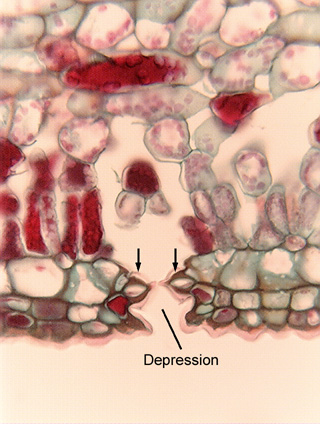 Fig.
10.3-5. Magnification of stoma in fig leaf (Ficus). This is a sunken
stoma, sunken below the plane of the epidermis. It appears as if the
guard cells (arrows) are part of a hypodermis or the mesophyll, but they are
epidermis cells (without exception, guard cells form only in the epidermis), it
is just that the epidermis itself lines this small depression that has the stoma
at the bottom of it. A paradermal section that contained most of the ordinary
cells of the epidermis would miss all the stomata completely.
Fig.
10.3-5. Magnification of stoma in fig leaf (Ficus). This is a sunken
stoma, sunken below the plane of the epidermis. It appears as if the
guard cells (arrows) are part of a hypodermis or the mesophyll, but they are
epidermis cells (without exception, guard cells form only in the epidermis), it
is just that the epidermis itself lines this small depression that has the stoma
at the bottom of it. A paradermal section that contained most of the ordinary
cells of the epidermis would miss all the stomata completely.
By being sunken at the bottom of this depression, air in the depression is slightly protected from wind, and any molecule of water that escapes from the stoma may remain in the depression long enough to actually bounce back into the leaf rather than being blown away. See Fig. 10.23 on page 182 in Plant Anatomy (Mauseth) for more details.